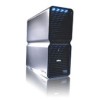Dell XPS 700 Jet Black Owner's Manual - Page 133
Multiple CPU Core, PS/2 Mouse Port
 |
View all Dell XPS 700 Jet Black manuals
Add to My Manuals
Save this manual to your list of manuals |
Page 133 highlights
Integrated Audio (On default) USB Controller (On default) 1394 Controller (On default) Serial Port #1 (Auto default) PS/2 Mouse Port (On default) LED color Performance Hyper-Threading (On default) Multiple CPU Core (On default) Enables or disables the onboard audio controller. • Off - Integrated audio is disabled. • On - Integrated audio is enabled. Enables or disables the internal USB controller. • Off - The USB controller is disabled. • On - The USB controller is enabled. • No Boot - The USB controller is enabled; however, the BIOS will not recognize USB storage devices. NOTE: Operating systems with USB support will recognize USB storage devices regardless of the No Boot setting. Enables or disables the integrated IEEE 1394 controller. • Off - The 1394 controller is disabled. • On - The 1394 controller is enabled. Disables or selects the address for the integrated serial port and determines how the serial port operates. • Off - The serial port is disabled. • Auto - The BIOS selects between COM1 and COM3; if both resources are in use the port is disabled. • COM1 - The port is configured at 3F8h with IRQ 4. • COM3 - The port is configured at 3E8h with IRQ 4. Enables or disables the onboard PS/2-compatible mouse controller. • Off - The PS/2 legacy mouse port is disabled. • On - The PS/2 legacy mouse port is enabled. Adjusts the color of the front and back LEDs (see "Front and Back View of the Computer" on page 13). Specifies whether each physical processor appears as one or two logical processors. • Off - Hyper-Threading technology is disabled. • On - Hyper-Threading technology is enabled. NOTE: If your processor does not supports Hyper-Threading, this option does not appear in the Options List. Specifies whether the processor has more than one core enabled. • Off - Multiple CPU core technology is disabled. • On - Multiple CPU core technology is enabled. NOTE: The performance of some applications may improve with an additional core enabled. Appendix 135















